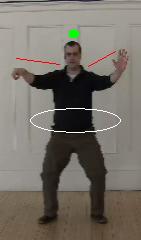As a Tai Chi teacher trying to educate people about relaxation, I come across some pretty common misconceptions. Which of the following two ways is how you think about your personal energy levels? Your answer will determine how well you can achieve whole body relaxation:
- Couch Potato Model of Relaxation -- How many people try to bust their butts during the day only to come home and completely crash at night? Maybe you play this out during the week and crash on the weekends? I call this cycle the Couch Potato Model of Relaxation. You have to become one with the cushions of your couch to recharge your batteries. This is a fundamental misconception about the nature of work and rest being like an on/off switch.
- Energy on a Dimmer Switch -- In tai chi and chi gung, we actually value the ability to seamlessly shift between high and low energy output, like a light on a dimmer switch. This is in direct contrast to the Couch Potato Model of Relaxation that alternates between complete crashes (the light is turned off) with the short, quick bursts of high energy (the light is turned on).
In the Dimmer Switch Model, relaxation has a form. In the Couch Potato Model, it is formless, floppy, and disconnected. In order to smoothly shift the gears of your energy level between complete relaxation and high output performance, you need to build an energetic matrix that supports this process. One of the best ways to build up your energy matrix is through a standing chi gung practice.
Exploring Inner Space
The secret to standing chi gung is exploring and opening up internal space. When the space inside the body feels open and connected, your energy flows cleanly throughout the entire body and you begin to move toward that effortless gearing up and down that we're talking about in the Dimmer Switch Model.
In this photo, I've highlighted some of the key "spaces" inside the body you'll pay attention to:

Here's what the highlights represent:
- White oval: the space around the middle internal organs and all the tissue in the pelvis
- Green dot: the lift through the crown of the head that completes the flow up the spine
- Red lines: the connection from the spine out to the fingertips
In standing chi gung, you do two distinct things. First you make these connections in order to build the right container for relaxation. Then, starting at the crown of the head, you let everything release downward. If this were the Couch Potato Model, you would simply collapse on the floor when you began to release down. Instead, you create an internal sensation of releasing and relaxing down, which uncovers the structure of the body, which counteracts the sinking down with an effortless buoyant force.
True whole body relaxation in chi gung comes from this dynamic interplay of natural buoyancy and complete letting go, playing out inside the body.
Here's a video I shot in this same posture, taken over a 30-minute period. I talk through the process of creating structure and then letting go. See if you can see buoyant moments and sinking moments.
How to Get Started
When you first begin to explore whole body relaxation through standing chi gung, you want to start with a very simple posture, as opposed to the one in the video:
- Let the arms hang by your sides
- Gently lift the skull off the spine, by tucking your chin slightly (feel like you're lifting your ears straight up)
- Place the tongue on the roof of your mouth
- Sit in the hips a little, like you're perched on a high stool
- Your feet should be hip-width apart and the legs should always be springy, not locked
Set a timer for 5 minutes and just begin to feel from the top of the head down to your feet and notice what you feel. At first, don't try to do anything. Notice different physical sensations and expect that there will be places that you can't feel into or that you'll skip over. That's normal.
As you do this practice more and more it will feel natural to want to stand for longer periods and you'll be able to tune into more subtle sensations. There is a method for releasing bound energy and opening up internal space. My teacher discusses it in detail in his book about this practice, called Opening the Energy Gates of Your Body. You can experiment on your own, with the book for guidance, or by checking in with a qualified instructor. Compared to lots of other practices though, you make the most progress toward relaxation when you put in the time just standing. Eventually, the rush of fluids, the sinking of chi, and the releasing of the nerves, all skills that contribute to whole body relaxation, will become a habit. You'll find yourself "letting go" throughout your day. When you cross this threshold, you know you've moved into the Dimmer Switch Model of relaxation.
So remember, don't just do something, stand there!

Share this post
Twitter
Google+
Facebook
Reddit
LinkedIn
StumbleUpon
Pinterest
Email